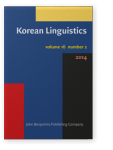The perception of Seoul Korean fricatives by listeners from five different native dialect and language groups
Previous studies have investigated the acoustic properties of Korean sibilant fricatives, with some attention given to effects of native dialect and language on both their production and perception. The current study investigates the effects of native dialect and language on the perception of Seoul Korean fricatives by testing the identification of fricative-initial CVs by native Korean speakers from Seoul, Daegu, and Jeju, as well as native Mandarin and Japanese second language learners of Korean. The results show that although native Korean listeners are far more accurate than non-native listeners, there was no significant variation within the native and non-native groups themselves. The results also show an inverse relationship between identification accuracy and vowel height that was consistent across both native and non-native listeners. This finding is in line with previous studies showing that the cues to the contrast are stronger in low vowel contexts than in high vowel contexts.
References
Anderson, Victoria, Insung Ko & William O’Grady
Baik, Woonil
1998 On Tensity of Korean Fricatives (Electropalatographic Study).
Speech Sciences 4.1: 135–145.

Chang, Charles B
2007 Korean Fricatives: Production, Perception, and Laryngeal Typology.
UC Berkeley Phonology Lab Annual Report 20–70.

Cheon, Sang Yee
2005 Production and Perception of Phonological Contrasts in Second Language Acquisition: Korean and English Fricatives. Ph. D. dissertation, University of Hawai‘i at Mānoa.
Cho, Taehong, Sun-Ah Jun & Peter Ladefoged
2002 Acoustic and Aerodynamic Correlates of Korean Stops and Fricatives.
Journal of Phonetics 30.2: 193–228.


Gim, Yeong Song
1963 Kyengnampangenuy umwun [The phonology of the South Gyeongsang dialect].
Kwukekwukmwun Hakci [
The Journal of Korean Language and Literature] 41: 51–64.

Hanson, Helen M
1997 Glottal Characteristics of Female Speakers: Acoustic Correlates.
Journal of the Acoustical Society of America 101.1: 466–481.


Holliday, Jeffrey J
2012 The Acoustic Realization of the Korean Sibilant Fricative Contrast in Seoul and Daegu.
Journal of the Korean Society of Speech Sciences 4.1: 67–74.


Holliday, Jeffrey J
2013 The Perceptual Assimilation of Korean Obstruents by Native Japanese Listeners.
Proceedings of the 2013 Spring Meeting of the Korean Society of Speech Sciences, 124–126.

Holliday, Jeffrey J
2014 The Perceptual Assimilation of Korean Obstruents by Native Mandarin Listeners.
Journal of the Acoustical Society of America 135.3: 1585–1595.


Jongman, Allard, Ratree Wayland & Serena Wong
2000 Acoustic Characteristics of English Fricatives.
Journal of the Acoustical Society of America 108.3: 1252–1263.


Kagaya, Ryohei
1974 A Fiberscopic and Acoustic Study of the Korean Stops, Affricates and Fricatives.
Journal of Phonetics 21: 161–180.


Kenstowicz, Michael & Chiyoun Park
2006 Laryngeal Features and Tone in Kyungsang Korean: A Phonetic Study.
Studies in Phonetics, Phonology and Morphology 12.2: 247–264.

Kim, Hyunsoon, Shinji Maeda, Kiyoshi Honda & Stephane Hans
2010 The Laryngeal Characterization of Korean Fricatives: Acoustic and Aerodynamic Data.
Turbulent Sounds: An Interdisciplinary Guide ed. by
Susanne Fuchs,
Martine Toda &
Marzena Zygis, 143–166. Berlin: Mouton de Gruyter.


Kim, Hyunsoon, Shinji Maeda & Kiyoshi Honda
2011 The Laryngeal Characterization of Korean Fricatives: Stroboscopic cine-MRI Data.
Journal of Phonetics 391: 626–641.


Kim, Sahyang
2001 The Interaction between Prosodic Domain and Segmental Properties: Domain Initial Strengthening of Fricatives and Post Obstruent Tensing Rule in Korean. M. A. thesis, University of California, Los Angeles.

Kim, Taek-ku
1991.
A Study of Geographical Differentiations in Kyongsangnam-do Dialects. Ph. D. dissertation, Konkuk University.
Kim, Young-Seon & Baek-Hee Kim
2013 A Study on the Phonological System of Uljin Dialect and Samchuck Dialect.
Wulimal Yenkwu [
Korean Language Research] 341: 141–162.

Klatt, Dennis H. & Laura C. Klatt
1990 Analysis, Synthesis, and Perception of Voice Quality Variations among Female and Male Talkers.
Journal of the Acoustical Society of America 87.2: 820–857.


Kong, Eun Jong, Mary E. Beckman & Jan Edwards
2011 Why are Korean Tense Stops Acquired so Early?: The Role of Acoustic Properties.
Journal of Phonetics 391: 196–211.


Lee, Goun & Allard Jongman
2012 Perceptual cues in Korean Fricatives. Poster presented at the 164th Meeting of the Acoustical Society of America. Kansas City, Kansas.

Lee, Hyunjung
2013 Evidence of Diachronic Sound Change: A Comparative Acoustic Study of Seoul and Kyungsang Korean. Ph. D. dissertation, University of Kansas.
Lee, Iksop & S. Robert Ramsey
2000 The Korean Language. Albany: SUNY.

Martin, Samuel E
1992 A Reference Grammar of Korean. Singapore: Tuttle.

Pyo, Hwa-Young, Ju-Hwan Lee, Seong-Hee Choi, Hyun-Sub Sim & Hong-Shik Choi
1999 An Acoustic and Aerodynamic Study of Korean Fricatives and Affricates.
Eumseong Gwahak [
The Korean Society of Speech Sciences] 61: 145–161.

Schneider, Walter, Amy Eschman & Anthony Zuccolotto
2002 E-Prime User’s Guide. Pittsburgh: Psychology Software Tools, Inc.

Yang, Byunggon
1996 A Comparative Study of American English and Korean Vowels Produced by Male and Female Speakers.
Journal of Phonetics 241: 245–261.


Yoon, Kyuchul
1999 A Study of Korean Alveolar Fricatives: An Acoustic Analysis, Synthesis, and Perception Experiment. M. A. thesis, University of Kansas.

Cited by
Cited by 3 other publications
Holliday, Jeffrey J.
2016.
Second Language Experience Can Hinder the Discrimination of Nonnative Phonological Contrasts.
Phonetica 73:1
► pp. 33 ff.

Holliday, Jeffrey J. & Minkyoung Hong
2020.
Non-word repetition may reveal different errors in naive listeners and second language learners.
Phonetics and Speech Sciences 12:1
► pp. 1 ff.

Schertz, Jessamyn & Yoonjung Kang
This list is based on CrossRef data as of 3 june 2024. Please note that it may not be complete. Sources presented here have been supplied by the respective publishers.
Any errors therein should be reported to them.
